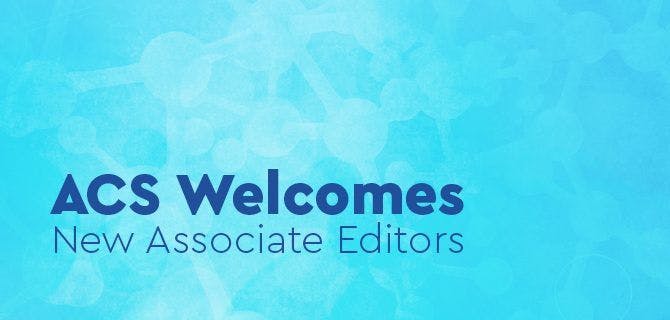New associate editors bring more than just changes to a publication’s masthead. They bring new experiences, new perspectives and new ideas to their publications. Get to know some of ACS’ latest editors and learn what unique gifts they’ll be bringing to their respective journals. *** Yaakov ‘Kobi’ Benenson, ACS Synthetic Biology What do you hope […]

***
Yaakov ‘Kobi’ Benenson, ACS Synthetic Biology
What do you hope to bring to your journal?
I hope to maintain the reputation of ACS Synthetic Biology as the premier publication venue in this exciting field. On the personal level, I hope to bring my expertise in mammalian synthetic biology, biological computing, and molecular programming. I would love to see more translational synthetic biology research in the journal.
Describe your current research.
Our focus is in mammalian synthetic biology, ranging from proof-of-concept construction of information-processing circuits in mammalian cells to applying these tools for novel therapeutics and their evaluation in animal models.
What are the major challenges facing your field today?
Automated circuit design tools have been envisioned as a key enabling technology that would transform the field of synthetic biology into a bona fide engineering discipline. Despite tremendous progress in recent years, we are still far from addressing many conceivable circuits. In part, the lack of quantitative understanding of many basic biological processes is to blame. The field needs more quantitative experimental characterization and quantitative modeling and simulation tools that can lead to actionable predictions and used by non-experts on a daily basis. Going forward toward industrial and biomedical translation, the models would need to take into account not only a synthetic system itself but also a highly complex environment in which the system operates.Photo Credit: ETH Zürich
***
Wonyong Choi, Environmental Science & Technology
What do you hope to bring to your journal?
I want to bring my expertise in environmental redox chemistry and semiconductor photochemistry to meet the increasing needs for eco-friendly technologies for cleaner water and air.
Describe your current research.
My research interests are mainly focused on photochemistry for solar energy conversion and environmental applications (in particular, semiconductor photocatalysis) and advanced oxidation processes, which are intensively investigated for various environmental remediation purposes. The needs for controlling recalcitrant and emerging pollutants at much lower concentration level beyond what traditional remediation technologies can handle justify the development of more advanced remediation technologies. Another research interest is to study the environmental chemical reactions occurring in frozen solutions. I want to understand how the chemical reactions in frozen media (e.g., ice, snow, frozen soils) are different from aquatic chemical reactions.
What are the major challenges facing your field today?
Traditional remediation technologies are focused on the efficient removal of pollutants in environmental media. Now people are asking more. Wastes and wastewaters are being recognized as new resources. The recovery of valuable elements, substances, and energy from wastes and wastewaters and the remediation and treatment processes that do not depend on the massive consumption of fossil fuel energy are urgently needed for sustainable development.
Do you have a recent paper in an ACS journal that you’d like to highlight?
Production of Molecular Iodine and Tri-iodide in the Frozen Solution of Iodide: Implication for Polar Atmosphere
Environ. Sci. Technol., 2016, 50 (3), pp 1280–1287
DOI: 10.1021/acs.est.5b05148
***
Zhi-Pan Liu, The Journal of Physical Chemistry A, B, C
What do you hope to bring to your journal?
One of the key tasks for physical chemistry is to establish fundamental theories for understanding chemistry in general. As a theoretician focusing on complex chemical reactions, in particular those occurring in solid and on solid surfaces, I wish to promote research on improving the predictive power of modern computational methods for chemical reactions, and enhancing the collaboration between theory and experiment in the area of physical chemistry.
Describe your current research.
My research focuses on the reactivity prediction of chemical systems for energy storage and conversion. Novel theoretical methods, such as the stochastic surface walking global optimization method, are developing in the group to search for novel structures of material and to identify low energy pathways. Our aim is to resolve the mechanism and kinetics of reactions via massively parallel computation in an automated way.
What are the major challenges facing your field today?
Novel materials and new chemical reactions emerge everyday, but few of them are really predicted from theory. The speed and accuracy of computation are the major bottleneck for solving complex problems in chemistry. It is a major challenge to develop new theoretical methods to speed up the calculations of hundreds of atoms at a high level of accuracy for material and reaction prediction.
Do you have a recent paper in an ACS journal that you’d like to highlight?
Graphite to Diamond: Origin for Kinetics Selectivity
J. Am. Chem. Soc., 2017, 139 (7), pp 2545–2548
DOI: 10.1021/jacs.6b11193
***
Kavirayani Prasad, Organic Letters
What do you hope to bring to your journal?
Describe your current research.
Our work is mainly focused on total synthesis of natural products of therapeutic significance and development of new synthetic strategies.
What are the major challenges facing your field today?
Inspite of an array of advances in various metal and non-metal mediated organic transformations, total synthesis of natural products and analogues of medicinal importance has remained a task far from perfection. Nature continues to challenge synthetic organic chemists with structural complexity and the proven importance of these compounds in drug discovery offers enormous avenues. I strongly believe that one of the major challenges is the necessity for a re-oriented approach towards the efficient synthesis of complex organic molecules. With the lessons learned from understanding the nature’s way of synthesis it is appropriate to reform the synthesis which will advance the drug discovery progression to a higher pedestal.
Do you have a recent paper in an ACS journal that you’d like to highlight?
Total Synthesis of the Bis-silyl Ether of (+)-15-epi-Aetheramide A.
Omkar Revu and Kavirayani R. Prasad*
J. Org. Chem., 2017, 82 (1), pp 438–460
DOI: 10.1021/acs.joc.6b02535
